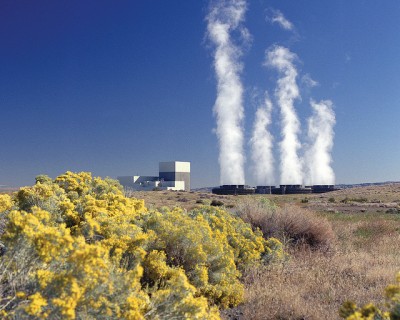
CGS Nuke Plant’s Near Miss
The Columbia Generating Station (CGS)—the nuclear reactor previously known as WPPSS No. 2 and located at Hanford, WA—had a near miss in December in 2016. A special inspection team sent in by the Nuclear Regulatory Commission (NRC) assessed three safety violations but it is the Union of Concerned Scientists (UCS) that has explained what happened to the public.
As nuclear reactors are very complicated, so too is the UCS explanation of what happened the morning of December 18, 2016. However, there is a bottom line: the NRC found that the events could have increased the risk of a reactor core damage by a factor of ten. This near miss proved, once again, that nuclear reactors do not always function as planned and that operator error is always a possibility.
The events of that day started—outside the plant, as they often do—with an electrical transient in the substation that connects the plant to the power grid. Cold weather prevented at least three of the substation’s breakers from opening. As a consequence, the plant’s main generator output breaker opened instead, which caused the turbine control valves to automatically close. This tripped the reactor, with the control rods’ inserting within seconds to stop the nuclear chain reaction.
So far, so good. But then the resulting drop in electricity inside the plant started a chain reaction of its own, as the plant responded to protect its own equipment from damage that can be caused by under-voltage. One of these responses was the closure of 
The closure of the valves had another reaction: stopping the supply of makeup cooling water to the reactor vessel. Amazingly, the pumps that provide this makeup water run off the steam supply that had now been shut off and the electrical backups were too weak to pump against the pressure in the reactor vessel.
Eight minutes after the event began, the operators started the Reactor Core Isolation Cooling (RCIC) system to provide the needed makeup cooling water. Ignoring procedures pertaining to open and closed positions of steam valves, they caused the RCIC safety system to shut itself down. Only after 13 minutes had passed did they reset the valves to allow the RCIC system to operate properly, while a foot of water boiled away in the reactor vessel.
Then the operators turned on the High Pressure Core Spray (HPCS) system, which refilled the reactor quickly. But instead of turning it off, they ran the HPCS system on “idle” for almost four hours, while 4.7 gallons a minute flowed into the reactor building. This leak was caused by the plant’s having failed to replace a gasket they had been told would deteriorate in 2007—10 years earlier.
Another near miss catalogued by UCS’s Dave Lochbaum. Read further details and diagrams here.
- RADIOACTIVE: THE WOMEN OF THREE MILE ISLAND
- Climate Action Without Nuclear
- CGS Nuke Plant’s Near Miss
- Columbia Generating Station Water Permit Challenged
- Columbia Generating Station Waste Discharges to Columbia River Challenged
- New Fire Risks in Nuclear Plants Spent Fuel Pools
- NRC Rejects NWEA’s Raising of Fukushima Issues in Relicensing of the Columbia Generating Station/WPPSS No. 2 Nuclear Plant
- In Memory of Dr. Rudi Nussbaum
- Petition to Suspend Licensing at Nuclear Power Facilities Pending Fukushima Investigation
- Getting the Real Facts about Radiation
